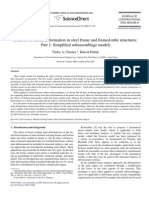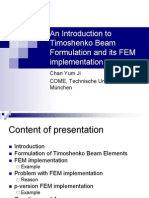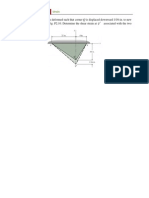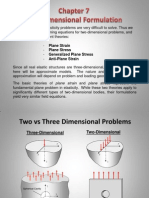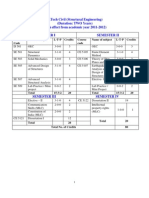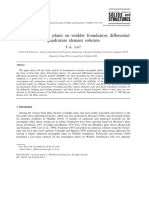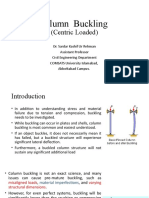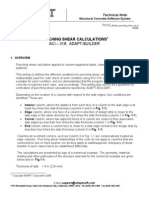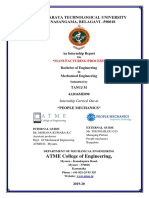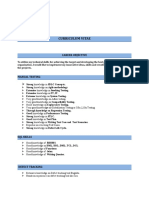Chapter2 170106173021 PDF
Chapter2 170106173021 PDF
Uploaded by
Rākesh RakhiCopyright:
Available Formats
Chapter2 170106173021 PDF
Chapter2 170106173021 PDF
Uploaded by
Rākesh RakhiOriginal Title
Copyright
Available Formats
Share this document
Did you find this document useful?
Is this content inappropriate?
Copyright:
Available Formats
Chapter2 170106173021 PDF
Chapter2 170106173021 PDF
Uploaded by
Rākesh RakhiCopyright:
Available Formats
Experimental Stress Analysis
Strain Analysis Method
Introduction:
For completely defining the strain or stress at a point on the surface of a component or structure,
generally it is necessary to measure strains along three different directions at that point. Multiple
element strain gauges or rosettes with strain gauges oriented along fixed directions are used for
this purpose.
When both the magnitude and directions of the principal strains at a point are unknown, a three
element strain gage is needed for the complete definition of strain at that point. Consider the case
where the three gauges in the rosette are placed at arbitrary angles related to the x-and y axis.
The strain along these directions A, B and C are related to strains ∈ ,∈ ,
∈ =∈ +∈ + sin cos
∈ =∈ +∈ + sin cos
∈ =∈ +∈ + sin cos
Where , and are the angles between the x-axis and the directions A, B and C respectively.
The magnitudes of strains ∈ , ∈ and ∈ are obtained through measurements on gauges oriented
along these directions. Hence ∈ ,∈ , can be found out by solving the simultaneous eq
The principal strains and principal directions are then determined through
1 1 ⁄
∈ = ∈ +∈ + ∈ −∈ +
2 2
1 1 ⁄
∈ = ∈ +∈ − ∈ −∈ +
2 2
tan 2∅ = ⁄ ∈ −∈
Department of Mechanical Engineering Page 1
Experimental Stress Analysis
Here ∅ is the angle between the x axis and the principal axis corresponding to strain ∈ . From
the principal strains ∈ and∈ , the principal stress and can be determined from
= (∈ + ∈ )⁄(1 − )
= (∈ + ∈ )⁄(1 − )
Several multiple element rosettes with gauges oriented along specified directions are
commercially available. These rosettes are denoted by the angles along which the gauges are
oriented in them as the three element rectangular rosettes, delta russets, four element rectangular
rosettes and tee-delta rosette.
Two element rectangular rosettes:
This rosette is suitable only when the directions of principal strain are known. The gage a is
arranged along the maximum strain direction chosen along the x-axis so that = 0 and the gage
b is set along the minimum strain direction so that = 90
Fig: Two gage rosette
The strain along these directions A, B is
∴ ∈ =∈
∈ =∈
Hence, ∈ = ∈ , ∈ = ∈ , = (∈ − ∈ )
The principal stress and can be
= (∈ + ∈ )∗
(1 − )
= (∈ + ∈ )∗
(1 − )
Department of Mechanical Engineering Page 2
Experimental Stress Analysis
= (∈ − ∈ )
2(1 + )
Three element rectangular rosettes:
In this rosette the three gage are laid out so that the axis of gauges B and C are at 45o and 90 o
respectively to the axis of gage A. taking the OA axis to be coincident with the O x-axis, the
angles corresponding to the gauges A, B and C in the three- element rectangular rosette are
=0 = 45 = 90
Than
∴ ∈ =∈ …………………………….. (1)
1
∈ = ∈ +∈ + … … … … … … … (2)
2
∈ =∈ … … … … … … … … … … … … … . (3)
We can rewrite these eq in terms of∈ , ∈ , are obtained as
∴ ∈ =∈
∈ =∈
= 2 ∈ − ( ∈ + ∈ )……………… (4)
The principal strains are given by
1 1 ⁄
∈ = ∈ +∈ + ∈ −∈ +
2 2
1 1 ⁄
∈ = (∈ +∈ ) + (∈ −∈ ) + 2 ∈ − ( ∈ + ∈ )
2 2
Department of Mechanical Engineering Page 3
Experimental Stress Analysis
1 1 ⁄
∈ = ∈ +∈ − ∈ −∈ +
2 2
⁄
∈ = (∈ +∈ ) − (∈ −∈ ) + 2 ∈ − ( ∈ + ∈ ) ………………….. (5)
Maximum shear strains
⁄
= ∈ −∈ +
⁄
= {(∈ −∈ ) + (2 ∈ −∈ −∈ ) } ……………… (6)
Principal strain directions are
tan 2∅ = ⁄ ∈ −∈
tan 2∅ = [ 2 ∈ − ∈ − ∈ ]⁄(∈ −∈ )……. (7)
Substituting eq 5 value in the general eq of the principal stress and and we get
= (∈ + ∈ )⁄(1 − )
∈ +∈ 1 ⁄
= + {(∈ −∈ ) + ( 2 ∈ − ∈ − ∈ ) }
2 (1 − ) (1 + )
= (∈ + ∈ )⁄(1 − )
∈ +∈ 1 ⁄
= − {(∈ −∈ ) + ( 2 ∈ − ∈ − ∈ ) }
2 (1 − ) (1 + )
Maximum shear stress is given by
=
2(1 + )
{(∈ −∈ ) + (2 ∈ −∈ −∈ ) } ⁄
=
2(1 + )
Three element delta rosettes:
In a three element delta rosette three gauges are placed at angular disposition of 0 o,120 o, 240 o .
for a delta rosette,
Department of Mechanical Engineering Page 4
Experimental Stress Analysis
=0 = 120 = 240
Than
∴ ∈ =∈ …………………………….. (1)
1
∈ = ∈ + 3 ∈ − √3 … … … … … … … (2)
4
1
∈ = ∈ + 3 ∈ + √3 … … … … … … … … … … … … … . (3)
4
We can rewrite these eq in terms of ∈ , ∈ , are obtained as
∈ =∈
1
∈ = ( 2(∈ +∈ )−∈ )
3
= (∈ −∈ )………………… (4)
√
The principal strains ∈ ∈ are
1 1 ⁄
∈ = ∈ +∈ + ∈ −∈ +
2 2
⁄
1 1 ∈ −2 ∈ −2 ∈ 2
∈ = (∈ +∈ +∈ ) + ∈ + + (∈ −∈ )
3 2 3 √3
Department of Mechanical Engineering Page 5
Experimental Stress Analysis
1 1 ⁄
∈ = ∈ +∈ − ∈ −∈ +
2 2
⁄
1 1 ∈ −2∈ −2 ∈ 2
∈ = (∈ +∈ +∈ ) − ∈ + + (∈ −∈ )
3 2 3 √3
The principle angle ∅ is obtained as
tan 2∅ = ⁄ ∈ −∈
2 ∈ −2 ∈ −2 ∈
tan 2∅ = (∈ −∈ ) ∈ +
√3 3
tan 2∅ = √3(∈ −∈ ) (2 ∈ −∈ −∈ )
Maximum shear strains
⁄
= ∈ −∈ +
⁄
∈ −2∈ −2∈ 2
= ∈ + + (∈ −∈ )
3 √3
⁄
2 2 ∈ −∈ −∈
= + (∈ −∈ )
√3 √3
The principal stresses are
= (∈ + ∈ )⁄(1 − )
⁄
(∈ +∈ +∈ ) 2 2 ∈ −∈ −∈
= + + (∈ −∈ )
3(1 − ) √3(1 + ) √3
= (∈ + ∈ )⁄(1 − )
⁄
(∈ +∈ +∈ ) 2 2 ∈ −∈ −∈
= − + (∈ −∈ )
3(1 − ) √3(1 + ) √3
Department of Mechanical Engineering Page 6
Experimental Stress Analysis
Four element rectangular rosettes:
In a four element rectangular rosette four gauges are placed at angular disposition of 0o,45o, 90o ,
135o.
= 0, = 45 , = 90 , = 135
∴ ∈ =∈ …………………………….. (1)
1
∈ = ∈ +∈ + … … … … … … … (2)
2
∈ =∈ … … … … … … … … … … … … … . (3)
1
∈ = ∈ +∈ − … … … … … … … (4)
2
Solving for ∈ , ∈ , we get
∈ =∈
∈ =∈
=∈ −∈ ……………….. (5)
The principal strains are given by
1 1 ⁄
∈ = ∈ +∈ + ∈ −∈ +
2 2
1 1 ⁄
∈ = (∈ +∈ ) + {(∈ −∈ ) + (∈ −∈ ) }
2 2
1 1 ⁄
∈ = ∈ +∈ − ∈ −∈ +
2 2
Department of Mechanical Engineering Page 7
Experimental Stress Analysis
1 1 ⁄
∈ = (∈ +∈ ) − {(∈ −∈ ) + (∈ −∈ ) }
2 2
tan 2∅ = ⁄ ∈ −∈
1 ∈ −∈
∅ = tan
2 ∈ −∈
The principal stress are given by
= (∈ + ∈ )⁄(1 − )
(∈ +∈ ) [(∈ −∈ ) + (∈ −∈ ) ] ⁄
= +
2 (1 − ) (1 + )
= (∈ + ∈ )⁄(1 − )
(∈ +∈ ) [(∈ −∈ ) + (∈ −∈ ) ] ⁄
= −
2 (1 − ) (1 + )
Maximum shear strains
⁄
= ∈ −∈ +
⁄
= {(∈ −∈ ) + (∈ −∈ ) }
Maximum shear stress is given by
=
2(1 + )
{(∈ −∈ ) + (∈ −∈ ) } ⁄
=
2(1 + )
Four element delta rosettes:
In a four element rectangular rosette four gauges are placed at angular disposition of 0o,60o, 120 o
, 90o.
= 0, = 60 , = 120 , = 90
∴ ∈ =∈ …………………………….. (1)
1
∈ = ∈ + 3 ∈ + √3 … … … … … … … (2)
4
Department of Mechanical Engineering Page 8
Experimental Stress Analysis
1
∈ = ∈ + 3 ∈ − √3 … … … … … … … … … … … … … . (3)
4
∈ =∈ … … … … … … … (4)
Solving for ∈ , ∈ , we get
∈ =∈
∈ =∈
= (∈ −∈ )……………….. (5)
√
The principal strains are given by
1 1 ⁄
∈ = ∈ +∈ + ∈ −∈ +
2 2
⁄
1 1 4
∈ = (∈ +∈ ) + (∈ −∈ ) + (∈ −∈ )
2 2 3
1 1 ⁄
∈ = ∈ +∈ − ∈ −∈ +
2 2
⁄
1 1 4
∈ = (∈ +∈ ) − (∈ −∈ ) + (∈ −∈ )
2 2 3
tan 2∅ = ⁄ ∈ −∈
1 2(∈ −∈ )
∅ = tan
2 √3(∈ −∈ )
The principal stress are given by
= (∈ + ∈ )⁄(1 − )
⁄
4
(∈ +∈ ) (∈ −∈ ) + (∈ −∈ )
= + 3
2 (1 − ) (1 + )
= (∈ + ∈ )⁄(1 − )
⁄
4
(∈ +∈ ) (∈ −∈ ) + (∈ −∈ )
= − 3
2 (1 − ) (1 + )
Maximum shear strains
Department of Mechanical Engineering Page 9
Experimental Stress Analysis
⁄
= ∈ −∈ +
⁄
4
= (∈ −∈ ) + (∈ −∈ )
3
Maximum shear stress is given by
=
2(1 + )
⁄
4
= (∈ −∈ ) + (∈ −∈ )
2(1 + ) 3
Transverse sensitivity error in rosettes:
In the analysis presented above the strain gage readings were assumed to be free from errors due
to transverse sensitivity effects. However, in actual practice the effect of transverse sensitivity
should be studied while measuring the stresses in a biaxial stress field with strain gauges. If it is
found that the error due to transverse sensitivity effect is significant, the strain gage readings
should be corrected for it.
Two element rectangular rosette:
Consider first a two-element rosette, with the gage axes aliened with two perpendicular axes x
and y on the test surface. It is assumed that the individual gage elements in the rosette have the
same transverse sensitivity.
Where∈ and ∈ are strains indicated by gauges along x and y directions respectively. ∈ and
∈ are the corresponding corrected strains.
1−
∈ = ∈ − ∈
1−
1−
∈ = ∈ − ∈
1−
The equations given above are for the gage elements oriented along any two orthogonal axes, x
and y. in actual practice the two element rectangular rosette is generally used with the axes of the
gage oriented along the principal axes. In such case x and y axes would denote the principal
axes.
1−
∈ = (∈ − ∈ )
1−
Department of Mechanical Engineering Page 10
Experimental Stress Analysis
1−
∈ = (∈ − ∈ )
1−
Three element rectangular rosette:
The individual strain readings,∈ , ∈ , ∈ , of a three element rectangular rosette can be corrected
for transverse sensitivity effects as follows. The corrected strains∈ , ∈ along the orthogonal
axes A and B respectively are
1−
∈ = (∈ − ∈ )
1−
1−
∈ = (∈ − ∈ )
1−
From the condition (∈ +∈ ) is an invariant, the strain along axis D orthogonal to axis B can be
estimated as
∈ =∈ +∈ −∈
Substituting the orthogonal strains∈ and ∈ , the corresponding strain ∈ is obtained.
1−
∈ = ∈ − (∈ +∈ −∈ )
1−
The corrected strains are used along with equations given to determine the principal strains,
stress and principal directions.
Three element delta rosette:
Expressions for correcting individual strain readings from a delta rosette for transverse
sensitivity effects can be easily derived for the case where all the three gage element have the
same transverse sensitivity k.
1− 2
∈ = 1+ ∈ − (∈ +∈ )
1− 3 3
1− 2
∈ = 1+ ∈ − (∈ +∈ )
1− 3 3
1− 2
∈ = 1+ ∈ − (∈ +∈ )
1− 3 3
Department of Mechanical Engineering Page 11
Experimental Stress Analysis
Shear strain gauges:
Strain gauges do not respond to shear strains. However the relationship between shear and
normal strains can be utilized to obtain from a strain rosette an output directly proportional to the
shear strain in the surface.
The two strain gauges a and b oriented so that the x axis bisects the angle between the gage axes.
Strain along two gage axes is
∈ +∈ ∈ −∈
∈ = + cos 2 + sin 2
2 2 2
∈ +∈ ∈ −∈
∈ = + cos 2 − sin 2
2 2 2
From the above eq. The shear strain is
∈ −∈
=
sin 2
From above eq the difference in the normal strain sensed by any two arbitrarily oriented gauges
in a uniform strain field is directly proportional to the shear strain along an axis bisecting the
included angle between the strain gage axes. When the included angle is 900, i.e. the rosette is a
two-element rectangular rosette, above eq can be reduced to
=∈ −∈
Hence by orienting a two-element rectangular rosette such that the x-axis bisects the 900 angle
between the gage elements and connecting the gage elements in the adjacent arm of a
Wheatstone bridge, an output from the rosette equal to the shear strain can be obtained
directly.
Department of Mechanical Engineering Page 12
Experimental Stress Analysis
Stress gauges:
In some application it may be desirable to have an output from a single strain gage directly
proportional to the axial stress in a particular direction. Such gauges are known as stress gauges.
For eg, if one wishes to determine the stress at say, five stations along specified directions under
dynamic loading, the use of stress gage in place of strain rosettes results in considerable saving
in equipment. The principle of operation of a stress gage is given below.
Stress gauge
Mohr’s circle of strain
Department of Mechanical Engineering Page 13
Experimental Stress Analysis
Fig 1 shows the sketch of a stress gage with its axis along the x-axis. The gage is oriented such
that the x-axis bisects the angle 2 between the grid elements A and B of this gage.
The strains along the grid elements A and B are given by
∈ = ( + )+ ( − ) 2( − )…………. (a)
∈ = ( + )+ ( − ) 2( + )………… (b)
The average of these will be
∈ +∈ = ( + )+ ( − )[ 2( + )+ 2( − )]…………. (c)
On expanding the cosine terms in above eq
∈ +∈ = ( + )+ ( − ) 2 2 …………. (d)
From Mohr’s strain circle
∈ +∈ =∈ +∈ ………..... (e)
∈ −∈ = (∈ −∈ ) cos 2 ………. (f)
Substituting the values in eq e and f in eq d and simplifying
1 1 1
∈ +∈ = + + − 2
2 2 2
1 1 1
∈ +∈ = + + − (2 − 1)
2 2 2
1 1 1
∈ +∈ = + + − − −
2 2 2
1
∈ +∈ = − +
2
1
∈ +∈ = + (1 − )
2
1
∈ +∈ = +
2
∈ +∈ = + ……………….(g)
If is so chosen that it is equal to tan √ then
Department of Mechanical Engineering Page 14
Experimental Stress Analysis
w.k.t
1= +
Substituting the value of in above eq
(1 + ) = 1
= ……………. (h)
Substituting these values in eq g yields
∈ +∈ = + …………….. (i)
However,
= ∈ + ∈ ………(j)
Substituting the values of ∈ + ∈ from eq I and j gives
= ∈ +∈ ………………. (1)
( ⁄ )
It may be noted that ∈ +∈ is the strain indicated by the stress gage, i.e. . thus
the stress along the x-axis is obtained by multiplying the strain indicated by the stress gage
with /(1 − ) .
If the direction of the maximum principal stress is known, a single conventional strain gage
can be used as shown in fig 3 to directly measure the principal stress . In this case as is zero
from eq a and b,
∈ =∈ =∈ ……… (k)
Substituting this condition in eq 1 gives
= = ∈ ………. (2)
Hence to measure the principle stress it is only necessary to orient a single strain gage
along = tan √ a direction at an angle to the axis and multiply the strain gage reading by
.
Department of Mechanical Engineering Page 15
You might also like
- PDF Dynamic Analysis of StructuresDocument43 pagesPDF Dynamic Analysis of StructuresChegue BureNo ratings yet
- Experimental 01Document37 pagesExperimental 01ayadNo ratings yet
- Strength Degradation Analysis of Notched Plain Concrete Beam (1) NewDocument15 pagesStrength Degradation Analysis of Notched Plain Concrete Beam (1) NewPradip SarkarNo ratings yet
- Advanced Mechanical Vibrations: Homework No. 1Document6 pagesAdvanced Mechanical Vibrations: Homework No. 1Mohanad Al-tahrawiNo ratings yet
- DCS - Design of Beams - Lect2Document15 pagesDCS - Design of Beams - Lect2Saket ThakkarNo ratings yet
- Nonlinear Spring Element (Combin 39)Document19 pagesNonlinear Spring Element (Combin 39)mansoor_yakhchalian2No ratings yet
- Plane Stress - MSE 305-1Document149 pagesPlane Stress - MSE 305-1Oloyede RidwanNo ratings yet
- Modal Analysis of MDOF Forced Undamped SystemsDocument11 pagesModal Analysis of MDOF Forced Undamped Systems王轩No ratings yet
- 4 Node QuadDocument27 pages4 Node QuadMathiew EstephoNo ratings yet
- Clough & Penzien E5-1Document3 pagesClough & Penzien E5-1Rubén Dario Chacin MarcanoNo ratings yet
- Sources of Elastic Deformation in Steel Frame and Framed-Tube Structures: Part 1: Simplified Subassemblage ModelsDocument14 pagesSources of Elastic Deformation in Steel Frame and Framed-Tube Structures: Part 1: Simplified Subassemblage ModelsAvi AuslenderNo ratings yet
- Shear Buckling AnalysisDocument20 pagesShear Buckling AnalysisstarspleshNo ratings yet
- Chan-An Introduction To Timoshenko Beam Formulation and Its FEM ImplementationDocument30 pagesChan-An Introduction To Timoshenko Beam Formulation and Its FEM ImplementationamaliaconstantinNo ratings yet
- Chapter 8 PrestressedDocument41 pagesChapter 8 PrestressedNurhafizah Ahmad100% (1)
- Chapter 5b Crystal Imperfections DislocationsDocument94 pagesChapter 5b Crystal Imperfections DislocationsSayantan DexNo ratings yet
- Nonlinear Shell TheoryDocument27 pagesNonlinear Shell TheorychacrdNo ratings yet
- Materials Engineering: Pangasinan State University Urdaneta Campus Mechanical Engineering DepartmentDocument7 pagesMaterials Engineering: Pangasinan State University Urdaneta Campus Mechanical Engineering DepartmentiamjemahNo ratings yet
- Ahsanullah University of Science and Technology: Materials", 7Document1 pageAhsanullah University of Science and Technology: Materials", 7Md. Azizul HakimNo ratings yet
- Chapter6 StiffnessMethodDocument11 pagesChapter6 StiffnessMethodkaranfilhasanNo ratings yet
- Chapter 5: TorsionDocument106 pagesChapter 5: Torsionprabin gautamNo ratings yet
- Strain: Strength of MaterialsDocument5 pagesStrain: Strength of MaterialsDon MatiasNo ratings yet
- HW1Document3 pagesHW1Naveen RajNo ratings yet
- Newmark IntegrationDocument12 pagesNewmark IntegrationOvidiu GenteanuNo ratings yet
- Cap. 7 - Skew Bending PDFDocument66 pagesCap. 7 - Skew Bending PDFDacu CiprianNo ratings yet
- ANALYSIS OF STRAINS Assignment 2 PDFDocument3 pagesANALYSIS OF STRAINS Assignment 2 PDFLuWang Alex100% (1)
- Structures Lab 1 - Cantilever Flexure BeamDocument12 pagesStructures Lab 1 - Cantilever Flexure BeamDavid Clark100% (4)
- Homework - Deriving Almansi Strain in Terms of DisplacementDocument2 pagesHomework - Deriving Almansi Strain in Terms of DisplacementJohn Mark Go PayawalNo ratings yet
- Assignment 02Document2 pagesAssignment 02Sailesh BastolNo ratings yet
- B K Constrained Modulus.: 4.9. Prandtl-Reuss Material Model (12 Theory) 213 ADocument1 pageB K Constrained Modulus.: 4.9. Prandtl-Reuss Material Model (12 Theory) 213 Aahmed shakerNo ratings yet
- Chapter 8 - Types of Finite Elements - A4Document9 pagesChapter 8 - Types of Finite Elements - A4GabrielPaintingsNo ratings yet
- Design and Behavior of Gusset Plate Connections PDFDocument12 pagesDesign and Behavior of Gusset Plate Connections PDFAnkit GuptaNo ratings yet
- 2.1 Composite Beam Section PropertiesDocument13 pages2.1 Composite Beam Section PropertiesCarlo Gimarino SalazarNo ratings yet
- Modeling The Hysteretic Response of Mechanical Connections For Wood StructuresDocument11 pagesModeling The Hysteretic Response of Mechanical Connections For Wood StructuresSheff_studentNo ratings yet
- ME223 - Assignment 9 SolutionsDocument5 pagesME223 - Assignment 9 SolutionsShivang100% (1)
- Structural Dynamics and Earthquake EngineeringDocument76 pagesStructural Dynamics and Earthquake EngineeringGerman ToledoNo ratings yet
- 10 Viscoelasticity 04 Hereditaory PDFDocument12 pages10 Viscoelasticity 04 Hereditaory PDFletter_ashish4444No ratings yet
- 1 D Structures Basic ConceptsDocument42 pages1 D Structures Basic ConceptsDev MitraNo ratings yet
- Redistribution of MomentsDocument29 pagesRedistribution of MomentsShita AlemieNo ratings yet
- Chapter 7 Two-Dimensional FormulationDocument18 pagesChapter 7 Two-Dimensional FormulationHk Lorilla QuongNo ratings yet
- The Direct Stiffness Method: Assembly and SolutionDocument14 pagesThe Direct Stiffness Method: Assembly and SolutionShubhankar BhowmickNo ratings yet
- DTD Handbook: Section 2.2.6.3. Crack Opening DisplacementDocument4 pagesDTD Handbook: Section 2.2.6.3. Crack Opening Displacementpouya_msNo ratings yet
- 4 Circular Plates & DiaphragmsDocument40 pages4 Circular Plates & DiaphragmsGiovani CarpinNo ratings yet
- Equivalent Plastic StrainDocument1 pageEquivalent Plastic Strainardi7020023615No ratings yet
- 2.13 Nonlinear Finite Element Analysis of Unbonded Post-Tensioned Concrete BeamsDocument6 pages2.13 Nonlinear Finite Element Analysis of Unbonded Post-Tensioned Concrete Beamsfoufou2003No ratings yet
- Structure SyllabusDocument25 pagesStructure SyllabuspraveennagarajanNo ratings yet
- Finite Element Method For Structural Dynamic and Stability AnalysesDocument43 pagesFinite Element Method For Structural Dynamic and Stability AnalysesabimalainNo ratings yet
- Rule of Mixtures PDFDocument5 pagesRule of Mixtures PDFkbaabujiNo ratings yet
- Finite Strain TheoryDocument19 pagesFinite Strain TheorySnehasish BhattacharjeeNo ratings yet
- l3 MaterialsDocument32 pagesl3 MaterialsZaouiNo ratings yet
- 02-RCC1 Analysis of Flexural MembersDocument8 pages02-RCC1 Analysis of Flexural MembersMuhammad MurtazaNo ratings yet
- A.MAULANA MALIK MH Dinamika Struktur c10Document6 pagesA.MAULANA MALIK MH Dinamika Struktur c10Maulana MalikNo ratings yet
- Thick Plate On Elastic FoundationDocument21 pagesThick Plate On Elastic FoundationHasanain Almusawi100% (1)
- Column Buckling: (Centric Loaded)Document13 pagesColumn Buckling: (Centric Loaded)Muhammad sheryarNo ratings yet
- BeamExamples 368Document13 pagesBeamExamples 368Brian VisserNo ratings yet
- TN 192 Punching Shear Calculation in BuilderDocument24 pagesTN 192 Punching Shear Calculation in BuilderHieu100% (1)
- Evaluation of Fatigue Life For A Large Bus by Using The Virtual Test Model (VTM)Document34 pagesEvaluation of Fatigue Life For A Large Bus by Using The Virtual Test Model (VTM)yoseikan1972No ratings yet
- Mechanics of Materials 7th Edition Beer Solutions Manual Download PDFDocument51 pagesMechanics of Materials 7th Edition Beer Solutions Manual Download PDFnorouhaicu65100% (8)
- Cyclic Plasticity of Engineering Materials: Experiments and ModelsFrom EverandCyclic Plasticity of Engineering Materials: Experiments and ModelsNo ratings yet
- Damage Mechanics in Metal Forming: Advanced Modeling and Numerical SimulationFrom EverandDamage Mechanics in Metal Forming: Advanced Modeling and Numerical SimulationRating: 4 out of 5 stars4/5 (1)
- Freshers - One Pager - CampusDocument2 pagesFreshers - One Pager - CampusRākesh RakhiNo ratings yet
- Location: Bangalore (Immediate Joiners) Experience: 2-5 Years Roles & ResponsibilitiesDocument1 pageLocation: Bangalore (Immediate Joiners) Experience: 2-5 Years Roles & ResponsibilitiesRākesh RakhiNo ratings yet
- Post Details: Other BenefitsDocument1 pagePost Details: Other BenefitsRākesh RakhiNo ratings yet
- Internship ReportDocument56 pagesInternship ReportRākesh Rakhi75% (8)
- List of ProjectsDocument2 pagesList of ProjectsRākesh RakhiNo ratings yet
- Vtu Provisional Degree Certificate Marks Card ApplyDocument1 pageVtu Provisional Degree Certificate Marks Card ApplyRākesh RakhiNo ratings yet
- (Fi Rstname) (Sur Name) : Exper I Ence Cont ActDocument2 pages(Fi Rstname) (Sur Name) : Exper I Ence Cont ActRākesh RakhiNo ratings yet
- Ti T L Eoft Hecv: Car Eerst at Ement: Car Eersummar YDocument2 pagesTi T L Eoft Hecv: Car Eerst at Ement: Car Eersummar YRākesh RakhiNo ratings yet
- 15mel77 PDFDocument1 page15mel77 PDFRākesh RakhiNo ratings yet
- Combination Resume FormatDocument2 pagesCombination Resume FormatRākesh RakhiNo ratings yet
- Letter Payment of FeeDocument1 pageLetter Payment of FeeRākesh RakhiNo ratings yet
- Functional Resume FormatDocument2 pagesFunctional Resume FormatRākesh RakhiNo ratings yet
- Curriculum Vitae: Name: Contact No: Email IdDocument3 pagesCurriculum Vitae: Name: Contact No: Email IdRākesh RakhiNo ratings yet
- Fresher Resume PatternDocument3 pagesFresher Resume PatternRākesh RakhiNo ratings yet
- Curriculum Vitae: Career ObjectiveDocument3 pagesCurriculum Vitae: Career ObjectiveRākesh Rakhi100% (1)
- Curriculum Vitae: Name: Mobile: EmailDocument3 pagesCurriculum Vitae: Name: Mobile: EmailRākesh RakhiNo ratings yet
- Pengembangan Bahan Ajar Fisika Berbasis Scientific ApproachDocument12 pagesPengembangan Bahan Ajar Fisika Berbasis Scientific ApproachTri ArianiNo ratings yet
- Compact First 3rd Edition Teacher Book - Copy-13Document1 pageCompact First 3rd Edition Teacher Book - Copy-13Laurence CoxNo ratings yet
- Pulley Block: B.I.T., Mesra Engg - Mechanics LabDocument5 pagesPulley Block: B.I.T., Mesra Engg - Mechanics LabSanatan MurmuNo ratings yet
- Service Level Agreement For Software Work PDFDocument2 pagesService Level Agreement For Software Work PDFDavid UrquhartNo ratings yet
- Arteriovenous Malformation (AVM) : Signs and SymptomsDocument7 pagesArteriovenous Malformation (AVM) : Signs and SymptomsCj UritaNo ratings yet
- Linux Commands Notes For ProfessionalsDocument64 pagesLinux Commands Notes For Professionalsmel GobanNo ratings yet
- Journal of Scientific Exploration (OBE)Document220 pagesJournal of Scientific Exploration (OBE)minimike87No ratings yet
- Human FighterDocument3 pagesHuman FighterJeff SlickNo ratings yet
- Semi DetailedDocument4 pagesSemi DetailedAngelie LaurenNo ratings yet
- NBS NomenclatureDocument5 pagesNBS NomenclatureviksursNo ratings yet
- BoK 2019 Conference ProgramDocument16 pagesBoK 2019 Conference ProgramEmma Louise WhtmnNo ratings yet
- Statistics: Population and Sample Parameter and StatisticsDocument5 pagesStatistics: Population and Sample Parameter and StatisticsShanna Basallo AlentonNo ratings yet
- IV. Internal AnalysisDocument10 pagesIV. Internal Analysisearl concepcionNo ratings yet
- AssignmentDocument3 pagesAssignmentwilliamNo ratings yet
- Electronic TicketDocument17 pagesElectronic TicketAdireddy SatyatrinadhNo ratings yet
- 2nd PUC Model Question PaperDocument4 pages2nd PUC Model Question PaperMohd UmerNo ratings yet
- Liposomes As Sterile Preparation PDFDocument8 pagesLiposomes As Sterile Preparation PDFSiti LathifahNo ratings yet
- HTTP Pportal - PunjabDocument3 pagesHTTP Pportal - Punjabnaeem313100% (1)
- Dew Point and BubbleDocument6 pagesDew Point and BubbleRaj Solanki0% (1)
- MV-22B Osprey TestAndEvaluationDocument16 pagesMV-22B Osprey TestAndEvaluationmuhammad haidar razan hilmiNo ratings yet
- Operations and Functions in SQLDocument9 pagesOperations and Functions in SQLmansi.sharma042003No ratings yet
- Python Web Scraping TutorialDocument65 pagesPython Web Scraping Tutorialswathi sree86% (7)
- Applied Economics: Absolute Scarcity Is When A Good Is Scarce Compared To Its Demand. For Example, Coconuts AreDocument4 pagesApplied Economics: Absolute Scarcity Is When A Good Is Scarce Compared To Its Demand. For Example, Coconuts AreRoma MalasarteNo ratings yet
- SAG - Housekeeping NC IIIDocument7 pagesSAG - Housekeeping NC IIImiles1280No ratings yet
- 1st Course To TU FreibergDocument6 pages1st Course To TU Freibergmehtab ul hassanNo ratings yet
- Questions and AnswersDocument4 pagesQuestions and AnswersCatherine Joy delos SantosNo ratings yet
- (Tutorial) Changing ZPanel To Different PortDocument2 pages(Tutorial) Changing ZPanel To Different Portiklan_andaNo ratings yet
- Reference Case: TR Arabia Inspection in Saudi Shutdown ProjectDocument2 pagesReference Case: TR Arabia Inspection in Saudi Shutdown ProjectLaxmikant TiwariNo ratings yet
- Power Information Technology Company (PITC) Customer Data SummaryDocument8 pagesPower Information Technology Company (PITC) Customer Data SummaryUmeshNo ratings yet
- Ficha Técnica LF-72Document6 pagesFicha Técnica LF-72Jose Luis Arriola RuizNo ratings yet










